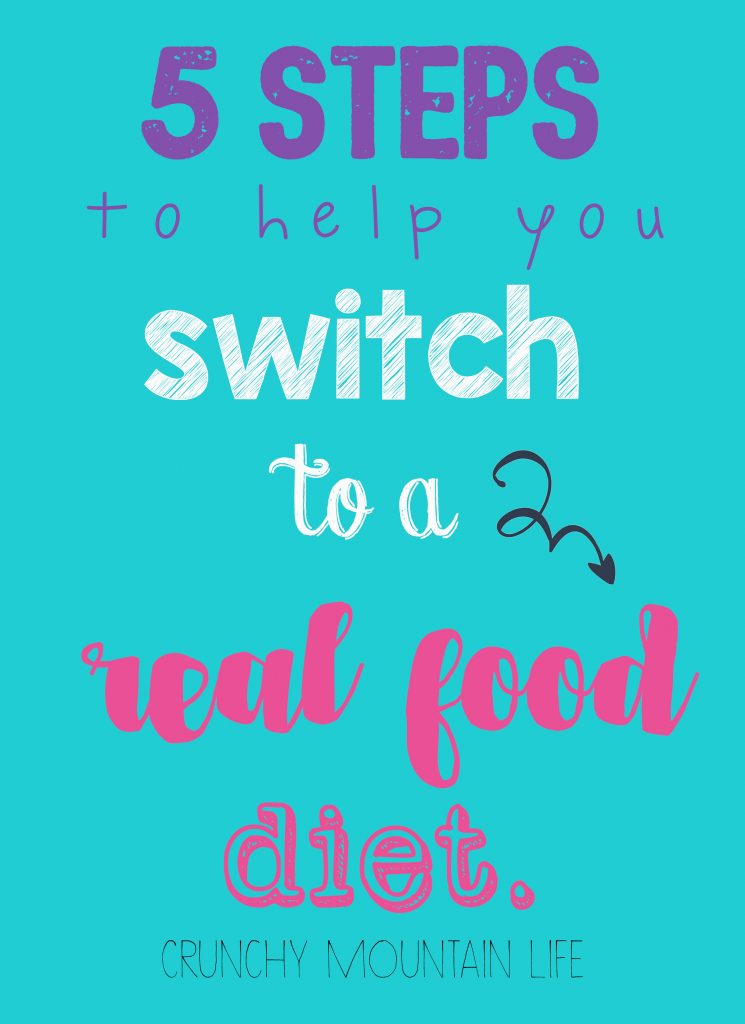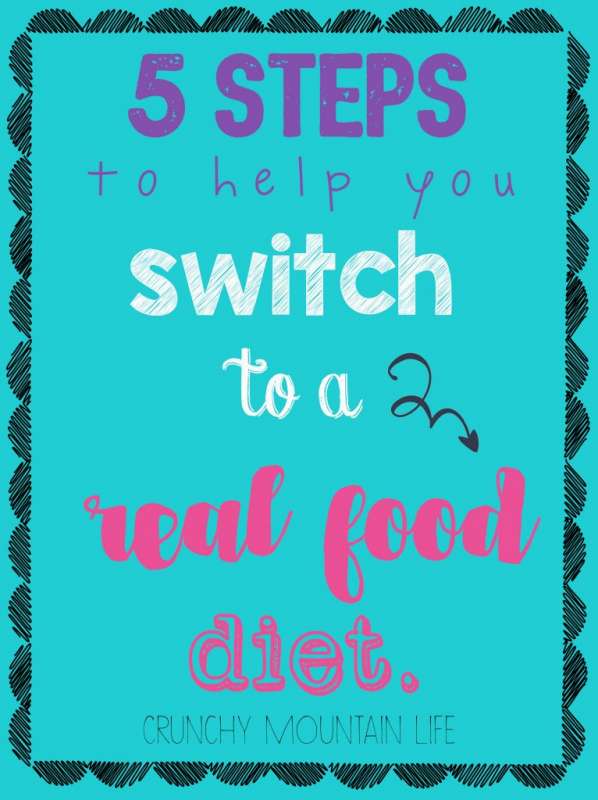I’d just like to start this post by saying that I am no “expert” on the subject of real food, but I do feel that I know quite a bit about how to go about this without stressing yourself out or breaking the bank. You see, today marks ONE YEAR for our family, since we started eliminating processed foods from our diets. It didn’t come easy at first. I had many stress-filled days, as I looked through the food we had just stocked our pantry with, and realizing that 90%…NINETY PERCENT, was not good for us. I felt like a failure as a mother.
The first few weeks…
The first few weeks were by far the hardest. I read so much information, watched educational videos and documentaries, and scoured the internet for facts, until my already drained mama brain couldn’t take any more. Every single item in our pantry that was not approved for a real food diet, was either tossed out or donated. I planned out the first few meals that I knew were in the “safe zone” of real food, and went to the store. Imagine how disheartened I was, when I realized how expensive the food that we needed was going to be. My first trip out, I went to 5 of the 7 grocery stores in our little town, to try to find food we could eat. The trip took several hours, and included lots of tears (and maybe a few choice words).
So through all of my struggles (and triumphs, we can’t forget the wins!), I have come up with 5 steps that you can take to help you make the switch over to real food, easier!
What is Real Food?
To switch to real food, you probably should know what that means. Real food is simply that. Just food. But real. When shopping for your food, you want to get the most natural form of whatever it is that you’re buying. Non-processed…or at least, very minimally processed, without all the chemicals and junk in them. When we do buy any packaged items, regardless of what it is, we always try to follow the 5 ingredient rule. The item must have no more than 5 ingredients, and they must all be real ingredients (ie: no added vitamins, nothing enriched, no preservatives, etc). If a packaged item (at least for my family) doesn’t meet these qualifications, back on the shelf it goes. No exceptions.
Why switch?
So much of the pre-packaged items you can buy are very strategically marketed, to make us think they are healthy, when in reality, they are the complete opposite. When you pick up a box of “healthy crackers” and see multiple vitamins shown under the ingredients list, that should be red flag #1. Those vitamins are originally found in whole wheat and whole grains, but when you look at the ingredients, you see it listed as “enriched” flour. That word is tricky and sounds good on the surface. Enriched must mean better right? After all, when you enrich your life, you’re making it better, so why wouldn’t it mean the same in regards to food? In fact, when a food is “enriched”, what that means is that many of the nutrients are removed from that food during processing. Nutrients are then added back in to replace those natural occurring vitamins and minerals that were lost, to “enrich” the food and “make it better”. Yikes.
Many of the issues that we struggle with can be linked to diet.
Those with Crohn’s or Celiac’s disease can attest to the fact that a Gluten free diet has been helpful in dealing with their autoimmune disease. So why wouldn’t other medical issues be connected with diet as well?
We’ve seen some changes in our own home, since making the switch. For one, J-Man has , as long as I can remember, has struggled with extremely sensitive skin, and would have constant issues with eczema flare ups. Bless his heart, he also had major digestive issues. The poor kid couldn’t catch a break. We tried everything to help him with both of these issues, but they always seemed like a temporary fix. A bandaid, if you will. After having been on our new diet for about 3 weeks, we began to see his skin clear up, and he began to have normal bowel movements. He was such a happier kid, now that he was starting to feel better!
When you know better, you do better, as they say.
Since it’s been such an incredible experience for our family, I felt compelled to share as much information about this as I could. I hope that you will find these steps easy and that you’ll see that it doesn’t have to be a scary or stressful process.

5 Steps
-
Commit.
I know this sounds obvious, but it’s probably the most important part. This is not something you can truly do, unless you are 100% committed to it. If the long term scares the mess out of you, or if you just have a hard time with commitment in general, then take it in baby steps. Start by giving yourself at least a month. Then another month, then another and so on. I promise, it gets easier. I’m not saying it has to be “all or nothing”, but I am saying that once you start, it’s going to take a daily resolve at first, to consciously make the right choices. I’ve heard people say that a habit becomes a habit with repetitive actions for a minimum of 21 days. If you think about it, you can do anything for 21 days. That’s not even a month. You got this.
-
Remove.
This is going back to that part I mentioned in the beginning, where I tossed out all of the “non-approved” foods. Now, you can approach this a few different ways. Our intention, was to gradually go through each item, and as we used up the “bad”, replace it with the good. This worked (for me), for about a day. After I had done my research, I couldn’t, in good conscience, keep eating that stuff, or feed it to my kids. So I just got rid of it all on day 2. Mountain Man was crazy enough to go along with me. That’s a good man right there.
-
Budget.
If you are like us, you don’t have extra money just laying around to spend on a ton of new food. So budgeting what we can and will spend each week is a must for us. If I go to the store without a set budget, I spend more, which usually results in me buying food that doesn’t get eaten, which results in waste. I hate waste. My mom and dad are probably chuckling to themselves right now, with this last statement. As a kid, I hated eating leftovers. I probably went to bed several nights, hungry, because I refused to eat leftovers, if that’s what was for dinner that night. Sorry, mom and dad! Aren’t you glad I know better now?! 😉
I’m going to be honest with you all on this. Budgeting is the one part that we are constantly working on. Sometimes we have good weeks, where we hit our budget- nail on the head. Other weeks we struggle sticking to it. Either way, Mountain Man and I have discussed in length, and both agree that if there’s one area we refuse to budge on, that is the health of our family. So breaking our budget once in awhile is okay with us.
-
Meal Plan.
I cannot stress this one enough. Plan, plan, plan. And when you think you’re done, plan some more. This will help you out immensely with #3. Figure out exactly what meals you want to make that week; breakfast, lunch, and dinner, and stick to it. I like to write down my meals, then I write down the ingredients I need for those meals, underneath them. Next, I check my pantry, fridge and freezer to see what I already have and mark that off the list. I also keep a list of staples that we eat all the time: whole wheat flour, eggs, milk, garlic, brown rice, coconut oil, honey… the list goes on, but you get the gist. Meal planning might be the 2nd biggest step of the whole process. If you go in unprepared, you will surely go over budget, end up buying more (or less) than you need, or even get frustrated and end up buying some of the old junk you used to.
-
Resources.
It’s important to arm yourself with knowledge, and surround yourself with people who will support you in your decision. I realize the 2nd part can be hard to do, especially as this way of eating is so foreign to so many people. That’s why it’s super important that your spouse or significant other are on board and ready to commit with you. If you’re not married, then finding a close friend or colleague might be a good option. Either way, having someone close to you who supports you in this lifestyle change, is über important. Even better if they want to join you in your journey!
I also highly recommend doing some reading and documentary watching. Knowledge is power, as they say, and this is one subject that will benefit you greatly to be knowledgable about! Not sure where to start? I recommend starting with the book 100 Days of Real Food, by Lisa Leake. This book was instrumental in getting our family started on the Real Food diet. Want a good documentary to watch that will blow your mind? Here‘s a short 3 minute preview to the documentary, “In Defense of Food” by Michael Pollan.
Now that you’ve taken the time to read this (hopefully I didn’t lose you before I got to the important stuff!), I hope you will begin to carefully consider starting this real food lifestyle for yourself! I’m here to help answer questions, or to simply be a voice of encouragement for you as you start this new journey. The first step is just resolving yourself to do it. You’ve got this. I know you can do it. Here’s to a healthier YOU!
This post is also linked over at Hodge Podge Moments! you can check it out, along with several other great posts from other bloggers!



Yes! Yes! I’m enjoying learning more about how to eat better! Thankful to have friends to take this journey with!
Awesome! I always love hearing of friends and family who are trying to make healthy changes in their lives. So glad to have you along for the ride, friend! <3
Thanks for linking up! We’re definitely working towards more whole foods and fewer processed ones. I don’t know that we’ll ever eliminate all of the processed ones but most days I feel pretty good about the items we choose to buy. I’ll definitely be keeping your tips in mind when I go to the store next though!